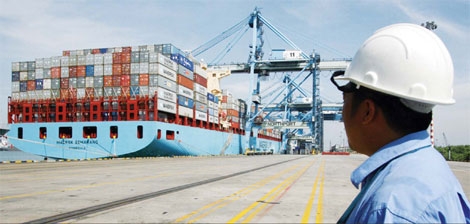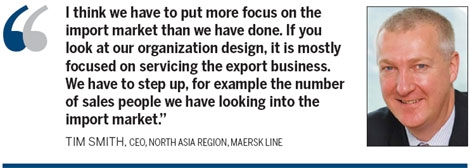Shipping giant sees calmer waters
Updated: 2010-12-24 13:19
By Wang Xiaotian (China Daily European Weekly)
|
 Maersk Line generated nearly $2.3 billion in profits in the first nine months of this year, aided by a 34 percent year-on-year increase in average freight rates and a 7 percent increase in volume. Goh Seng Chong / Bloomberg |
Maersk Line, one of the world's largest container carriers by volume and market value, is planning to further combine intra-Asia imports with its global export network to strengthen its advantages in the region.
Tim Smith, CEO for the North Asia region of the company, says the company is locked into China's increasing imports since the country normally buys raw materials or partly processed goods from other parts of Asia before assembling and sending them out as exports.
"I think we have to place more focus on the import market than we have done. If you look at our organization design, it is mostly focused on servicing the export business. We have to step up, for example, the number of sales people we have looking into the import market," he says.
Smith says the company also needs to look carefully at the rotation of vessels because most port designs are to ensure better export connections to principal destinations.
|
|
"The port rotation should be different because the ports for imports are not necessarily the same as the main ports for exports," he says.
Boosted by regional free trade development and strong growth, the intra-Asia sector will become the new focal point of the shipping market, says Bronson Hsieh, vice-group chairman of Evergreen Group and chairman of Evergreen Marine Corp.
In 2009, intra-Asia cargo volume reportedly dropped 2.6 percent year-on-year. During the first half of this year, cargo volume increased 16.9 percent from a year earlier period. The performance of both periods outstrips the long-haul markets from Asia to the United States and Europe.
Smith says he was very surprised by how quickly the industry has picked up from the global economic crisis despite the fact that several major economies still face uncertainties. He says that the golden era for the shipping industry has come and gone.
"I was wishing the horrible downturn was going to end this time last year. We were optimistic that things were going to improve. But I think we've been surprised by how fast it's become good," he says.
Global trade growth will increase 13.5 percent this year, according to the World Trade Organization, the biggest year-on-year increase since 1950 following a faster-than-expected recovery in trade flows. In 2009, world trade declined by 12 percent, the biggest slump since World War II.
After a historic loss of $2.1 billion (1.6 billion euros) in 2009, the Denmark-based Maersk Line witnessed a dramatic uptick in profits, with nearly $2.3 billion in the first nine months of this year that was aided by a 34 percent year-on-year increase in average freight rates and a 7 percent increase in volume.
"The situation in 2010 is a little bit better than the normal level," says Smith, a 25-year veteran of the shipping industry. He describes the business situation in 2010 as "strange" following unpredictable growth patterns quarter-by-quarter.
The second quarter of this year saw strong growth followed by unexpected average growth in the third quarter, and a slight decrease in the fourth quarter, which is unusual due to the annual expected year-end seasonal demand, he says.
But it's hard to predict whether the flourishing situation will continue next year. "The year 2011 will not necessarily be as good as this year as demand may slow," says Smith, adding the company needs to carefully monitor the demand and supply situation in order to react quickly.
He estimates a global demand growth of 8 percent next year compared with 2010, mainly driven by a continuous rise of freight demand in Asia, Latin America and Africa, but with more fluctuations month by month.
"Given the sophisticated global economic environment, cyclical turbulence will become more obvious, while volatility will grow more dramatically," says Wei Jiafu, president of China Ocean Shipping (Group) Co, which claims to be China's largest and the leading organization in global shipping, modern logistics and ship building and repairing.
Smith predicts a 10-12 percent year-on-year capacity growth as more new ships are delivered to owners in 2011 but calculating how much of it would be deployed is a different matter.
"I think (overcapacity) is manageable if the industry learns from what happened in 2009. I'm optimistic," he says.
Carriers will continue to practice slow steaming because of rising fuel prices despite the fact the toughest times are already far behind, says Smith, who adds 5 to 8 percent of capacity was taken out of circulation during the downturn.
Smith says it is difficult to predict how much freight rates will increase in the future but, based on current levels, the company expects to see good profits ahead.
Before the crisis, the industry witnessed an average annual demand increase of more than 10 percent. Globally, the average demand increase for containers was usually three times growth in gross domestic product. "But it will be more like 6 or 7 percent growth in the future," says Smith.
Another change in the market will be increasing concern from clients over clean and green transportation, Smith says.
"This is becoming a mega trend. The customers over a period of time will ask for us to be more environmentally friendly. They will maybe select the carriers more based on their environmental performance in the future. We want to prepare for it early."
Maersk Line vessels on Sept 7 officially began using low-sulfur fuel in their engines while at berth in Hong Kong, marking the first voluntary fuel-switch scheme in Asia.
Switching from bunker fuel, which is used on the high seas, to low-sulfur fuel will reduce Maersk Line's emissions of unhealthy sulphur oxides and particles by at least 80 percent, says the company. It will come at an added cost of $1 million annually.
"Shipping is very efficient in terms of cutting CO2 emissions compared with other means of transportation. But shipping's (sulphur oxides) emissions need to be dealt with," says Morten Engelstoft, COO at Maersk Line. He expects the voluntary initiative will inspire authorities to raise the regulatory bar.
For Smith, the recovery brought not only benefits and new challenges, but also some disappointment as opportunities for consolidation within the industry dispersed.
"Our feeling (one year ago) was that when the crisis hit, probably some weak companies should have gone out to business, but that didn't happen. Now that the global economy is improving again, probably the opportunity for consolidation has been missed," he says, adding it would be a disappointment for the industry because it could become stronger and more stable after more consolidation.
E-paper

Ear We Go
China and the world set to embrace the merciful, peaceful year of rabbit
Preview of the coming issue
Carrefour finds the going tough in China
Maid to Order
Specials

Mysteries written in blood
Historical records and Caucasian features of locals suggest link with Roman Empire.

Winning Charm
Coastal Yantai banks on little things that matter to grow

New rules to hit property market
The State Council launched a new round of measures to rein in property prices.

